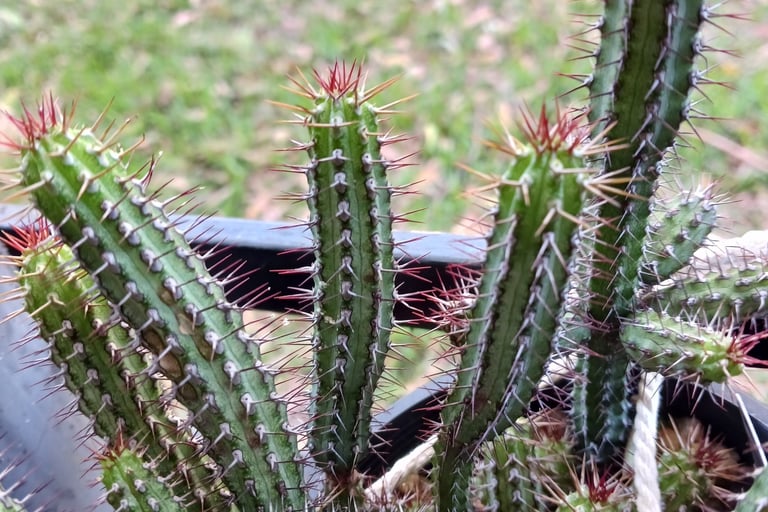Euphorbia baioensis
Updated: 19 October 2025
The Desert Sentinel: Exploring the Spiny Splendour of Euphorbia baioensis
I. Introduction
For the true succulent enthusiast and horticulturist, few plants possess the rugged, sculptural beauty and intriguing natural history of the Euphorbia baioensis. Hailing from the arid, rocky plains of East Africa, specifically Kenya, this species is a stunning example of adaptation, combining architectural form with a surprisingly easy-care nature. Often confused with other Euphorbia species that feature a swollen base (caudex), the genuine E. baioensis stands apart with its slender, clustering, and dramatically spiny columnar stems. It is a genuine showpiece, earning its reputation as a "Desert Sentinel."
II. Unveiling the True Form: Appearance and Structure
The most captivating feature of Euphorbia baioensis is its striking growth habit. Unlike its caudex-forming cousins, this species is a spiny succulent shrub. It grows in dense clumps of numerous, upright, slender, and often segmented stems that radiate from a main base, giving it a characteristic bushy or candelabra-like silhouette.
Stems: The stems are typically a lovely blue-green or grey-green colour, with a slightly waxy or glaucous coating that helps reduce water loss. They are segmented, with a series of low, prominent ridges or ribs running vertically down the length. Mature plants can reach heights of up to 30 to 60 cm (12 to 24 inches) and an equal width, creating a dense, thorny cushion over time.
Spines: Each ridge is adorned with dramatic, sharp spines, which are often a striking copper-red or steel-grey colour, contrasting beautifully with the blue-green stem. These spines typically occur in pairs and are actually modified, hardened stipules (small, leaf-like structures at the base of the leaves), a common feature in many African Euphorbia species. The density of the spines is what gives the plant its formidable and attractive texture.
Flowers (Cyathia): As a member of the Euphorbia genus, it produces small, specialised flowers called cyathia. These appear primarily in the late spring and summer at the tips of the new growth. They are typically tiny, butter-yellow, or greenish-yellow in colour. While not overtly showy like a desert rose, they add a subtle, charming contrast to the plant's spiny structure.
Leaves: Like many xerophytic Euphorbia species, the leaves are vestigial - extremely small, ephemeral, and drop off quickly in dry or hot conditions, giving the plant a near-leafless, "cactus-like" appearance.
III. A Look at Its Homeland: Ecology and Origin
Euphorbia baioensis is native to the arid and semi-arid regions of Kenya, particularly around the Baio area (from which it gets its name). It thrives in tropical desert and rocky habitats, enduring high temperatures, intense sun, and prolonged periods of drought.
Its physical characteristics are direct adaptations to this harsh environment. The dense clustering and spiny stems offer protection from grazing animals, while the glaucous, ribbed stems minimise surface area exposed to the sun and maximise water storage. Understanding its native environment - rocky, poor, and exceptionally well-draining soil - is the master key to its successful cultivation.
IV. Cultivating the Desert Sentinel: Essential Care Tips
Despite its exotic look, Euphorbia baioensis is surprisingly resilient and straightforward to grow, provided its core needs for light and drainage are met.
Light Requirements: This is a sun-loving species. It thrives in full sun (at least 6 hours of direct light) or very bright, strong indirect light. If grown indoors, a south-facing window (in the Northern Hemisphere) is essential. Insufficient light will cause the stems to stretch and become thin (etiolation), ruining the plant's compact, architectural form.
Soil and Drainage: Impeccable drainage is non-negotiable. The plant will quickly succumb to root rot in heavy, water-retentive soil. Use a specialized cactus or succulent potting mix, heavily amended with gritty materials such as perlite, pumice, or coarse sand. The soil should be porous and allow water to run through immediately.
Watering Regime: As a drought-tolerant desert dweller, Euphorbia baioensis needs sparse watering. Always allow the soil to dry out completely between waterings, and then water thoroughly. During the winter months, when the plant is dormant, watering should be reduced to an absolute minimum - perhaps once a month or less - to prevent the stems from shriveling excessively.
Temperature and Winter Care: It prefers warm to hot temperatures, ideally between 20°C and 30°C (68°F and 86°F) during the growing season. It is not frost-tolerant and must be protected from cold temperatures. Keep it above 10°C (50°F) to ensure its survival and prevent cold-induced damage.
Feeding: Fertilize sparingly. A diluted, balanced, or low-nitrogen liquid fertilizer can be applied once or twice during the active growing season (late spring and summer). Over-fertilizing can lead to weak, unnatural growth.
V. Propagation: Creating New Plants
Euphorbia baioensis is most commonly propagated via stem cuttings.
Take the Cutting: Using a clean, sharp knife, take a cutting from a healthy stem, ideally in spring or early summer.
Manage the Sap: Immediately rinse the cut end of both the mother plant and the cutting with cool water to stop the flow of the milky white latex sap. Wear gloves and eye protection, as this sap is toxic and can cause skin and eye irritation.
Callus: Allow the cutting to dry and form a protective scab (a callus) over the cut end. This usually takes between 3 days and a week, depending on humidity. This step is crucial for preventing fungal infections and rot
Planting: Plant the callused cutting in a small pot with the standard, well-draining succulent mix. Do not water immediately.
Rooting: Wait 1-2 weeks before the first light watering. Keep the cutting in a warm, bright spot. Rooting can take several weeks, but once established, the cutting will grow rapidly.
That's a great request! Focusing on pests and diseases will make the article much more comprehensive for a horticulturist. While the original article touched upon common issues, here is a detailed, expanded section on pests and diseases specific to the true, spiny columnar Euphorbia baioensis.
VI. Pests and Diseases
While Euphorbia baioensis is a robust and resilient plant, it is not entirely immune to problems. As a slow-growing succulent, its main threats come from overwatering and specific sap-feeding pests. Vigilance and proper cultural practices are the best defense.
A. Fungal and Bacterial Diseases (The Main Threat)
The most common and destructive diseases are almost always linked to excessive moisture and poor air circulation.
Root Rot (Fungal): This is the number one killer of E. baioensis.
Cause: Persistent overwatering, especially in cool or humid conditions, and soil that does not drain quickly. Fungal pathogens like Phytophthora thrive in waterlogged conditions and attack the roots and the base of the stem.
Symptoms: The stems become soft, mushy, and discoloured (often turning dark brown or black) near the soil line. The entire plant may suddenly collapse or detach from the root system.
Prevention & Treatment:
Prevention: Strict adherence to a "soak and dry" watering schedule. Ensure the pot has large drainage holes and use a very gritty, fast-draining soil mix.
Treatment: If caught early, a plant can sometimes be saved. Unpot the plant immediately, cut away all diseased, discoloured, or mushy roots and stem tissue back to healthy, white tissue. Allow the wounds to dry and callus for several days before repotting in fresh, dry, gritty soil.
Stem and Crown Rot (Bacterial/Fungal): Rot that moves up the stem or affects the main crown where the stems cluster.
Cause: Moisture lingering on the stems, particularly in the crevices where the segments or ribs meet, combined with high humidity. Physical damage can also introduce pathogens.
Symptoms: Dark, sunken, or weeping lesions appear on the stems, often spreading rapidly.
Prevention & Treatment: Ensure good air movement (a small fan is helpful indoors). Avoid overhead watering. If a stem is affected, cleanly excise it well below the infected area, sterilizing the cutting tool after each cut. Dusting the wound with sulfur powder can help seal and disinfect it.
B. Insect Pests (The Sap Suckers)
The thick, spiny stems can sometimes shelter small, sap-feeding pests.
Mealybugs: These are the most frequent pests.
Appearance: Small, white, cottony insects found clustered in the nooks between the stems, along the ribs, or on the roots (root mealybugs).
Damage: They suck the plant's sap, leading to stunted, weakened, and distorted growth. They also excrete sticky honeydew, which can lead to sooty mold.
Control:
Light Infestations: Treat by dabbing the visible pests directly with a cotton swab dipped in rubbing alcohol (isopropyl alcohol).
Heavy Infestations: Use a systemic insecticide approved for succulents, applied as a soil drench, or a horticultural oil (like neem oil) spray, ensuring it reaches all crevices.
Root Mealybugs: If the plant is struggling but the above-ground pests aren't visible, unpot it and check the roots. Treat the roots with an alcohol rinse or a systemic insecticide before repotting in fresh soil.
Spider Mites: These tiny arachnids thrive in hot, dry, still air.
Appearance: Fine webbing, usually found near the growing tips. The damage appears as tiny yellowish or silvery stippling on the stem surface.
Control: Increase air circulation and humidity (misting the soil around the plant, not the stem itself, can help indirectly). Treat with insecticidal soap or a miticide, focusing on thoroughly coating the affected areas.
Scale Insects: Small, hard, immobile bumps (often brown or tan) that attach to the stem.
Damage: Like mealybugs, they feed on sap, weakening the plant.
Control: Physically scrape them off with a fingernail or a soft brush. Follow up by treating the affected area with rubbing alcohol.
C. Nutritional and Environmental Issues
These are not true diseases but cause symptoms that can mimic them, often related to cultivation errors.
Etiolation (Stretching):
Cause: Insufficient light.
Symptom: The new stems grow long, thin, pale green, and weak, losing the desirable compact, columnar form.
Solution: Immediately move the plant to the brightest possible location. Etiolated growth will not revert to its proper shape, but future growth will be healthy and compact.
Sunburn (Scorching):
Cause: Sudden exposure to intense, direct sunlight, especially after being kept in lower light (e.g., bringing it outdoors in spring).
Symptom: Permanent white, yellow, or brown patches of dead tissue on the side of the stem exposed to the sun.
Prevention: Acclimatize the plant gradually to higher light levels over a period of 1 to 2 weeks.
VII. Safety Note: The Milky Secret
Like all members of the Euphorbiaceae family, E. baioensis produces a white, sticky latex sap when wounded. This sap is the plant's defense mechanism, and it is toxic. It can cause severe irritation to the skin and eyes, and is poisonous if ingested. Always use proper handling techniques - gloves and eye protection - when pruning, propagating, or moving the plant.
VIII. A Jewel for the Collector
Euphorbia baioensis is a coveted addition to any serious succulent collection. Its striking blue-green colour, dramatic spination, and dense, clumping habit provide a remarkable contrast in a rockery, a container garden, or a bright windowsill. It is a plant that demands respect for its form and its natural defenses, yet it rewards the attentive horticulturist with a durable, beautiful, and endlessly fascinating specimen that truly represents the wild, sculptural heart of the desert.
IX. Articles
X. VIDEOS


Connect
Stay updated with my online activities.
CONTACT
Engage
Email Me via the Link Below:
© 2025. All rights reserved.
